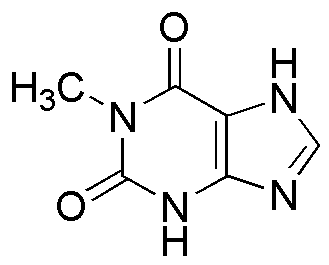1-Methylxanthine is widely utilized in research focused on:
- Pharmaceutical Development: This compound is studied for its potential therapeutic effects, particularly in respiratory diseases, where it may help relax bronchial muscles and improve airflow.
- Caffeine Research: As a structural analog of caffeine, it serves as a valuable tool in understanding the pharmacological effects of methylxanthines, aiding in the development of caffeine-related products.
- Neuroscience Studies: Researchers explore its role in modulating neurotransmitter systems, which can provide insights into cognitive function and mental health treatments.
- Food and Beverage Industry: It is used in the formulation of energy drinks and dietary supplements, appealing to consumers seeking enhanced energy and alertness.
- Veterinary Medicine: The compound is investigated for its effects on animal health, particularly in improving respiratory function in pets and livestock.
Informations générales
Propriétés
Sécurité et réglementation
Applications
1-Methylxanthine is widely utilized in research focused on:
- Pharmaceutical Development: This compound is studied for its potential therapeutic effects, particularly in respiratory diseases, where it may help relax bronchial muscles and improve airflow.
- Caffeine Research: As a structural analog of caffeine, it serves as a valuable tool in understanding the pharmacological effects of methylxanthines, aiding in the development of caffeine-related products.
- Neuroscience Studies: Researchers explore its role in modulating neurotransmitter systems, which can provide insights into cognitive function and mental health treatments.
- Food and Beverage Industry: It is used in the formulation of energy drinks and dietary supplements, appealing to consumers seeking enhanced energy and alertness.
- Veterinary Medicine: The compound is investigated for its effects on animal health, particularly in improving respiratory function in pets and livestock.
Documents
Fiches de données de sécurité (FDS)
La FDS fournit des informations de sécurité complètes sur la manipulation, le stockage et l’élimination du produit.
Spécifications du produit (PS)
Le PS fournit une description complète des propriétés du produit, notamment sa composition chimique, son état physique, sa pureté et les exigences de stockage. Il détaille également les plages de qualité acceptables et les applications prévues du produit.
Certificats d'analyse (COA)
Recherchez des certificats d'analyse (COA) en saisissant le numéro de lot du produit. Les numéros de lot et de lot se trouvent sur l'étiquette d'un produit, après les mots « Lot » ou « Lot de fabrication ».
Numéro de catalogue
Numéro de lot/série
Certificats d'origine (COO)
Ce certificat d'exploitation confirme le pays dans lequel le produit a été fabriqué, et détaille également les matériaux et composants utilisés et s'il est issu de sources naturelles, synthétiques ou autres sources spécifiques. Ce certificat peut être requis pour les douanes, le commerce et la conformité réglementaire.
Numéro de catalogue
Numéro de lot/série
Fiches de données de sécurité (FDS)
La FDS fournit des informations de sécurité complètes sur la manipulation, le stockage et l’élimination du produit.
DownloadSpécifications du produit (PS)
Le PS fournit une description complète des propriétés du produit, notamment sa composition chimique, son état physique, sa pureté et les exigences de stockage. Il détaille également les plages de qualité acceptables et les applications prévues du produit.
DownloadCertificats d'analyse (COA)
Recherchez des certificats d'analyse (COA) en saisissant le numéro de lot du produit. Les numéros de lot et de lot se trouvent sur l'étiquette d'un produit, après les mots « Lot » ou « Lot de fabrication ».
Numéro de catalogue
Numéro de lot/série
Certificats d'origine (COO)
Ce certificat d'exploitation confirme le pays dans lequel le produit a été fabriqué, et détaille également les matériaux et composants utilisés et s'il est issu de sources naturelles, synthétiques ou autres sources spécifiques. Ce certificat peut être requis pour les douanes, le commerce et la conformité réglementaire.


